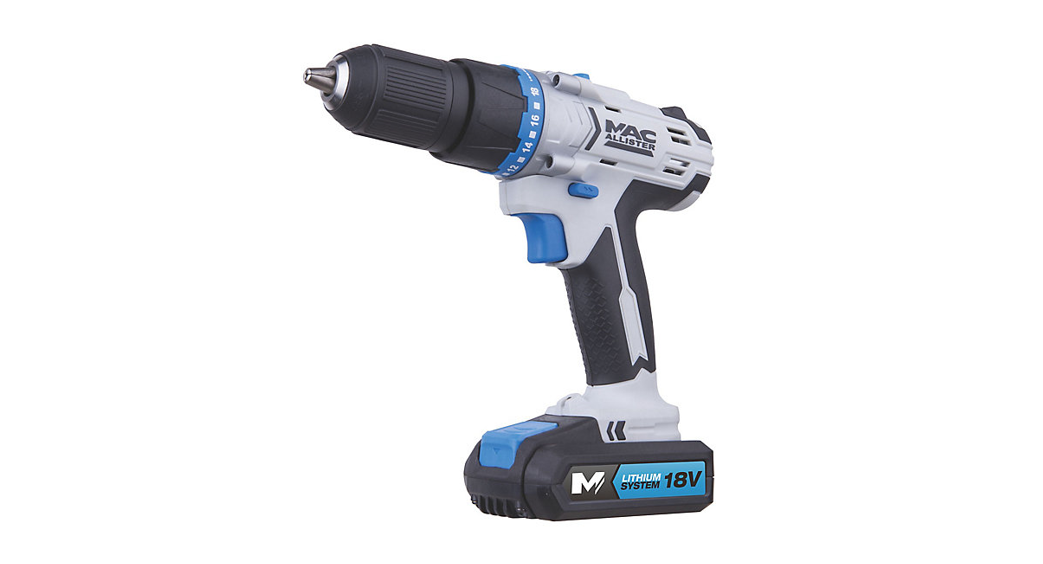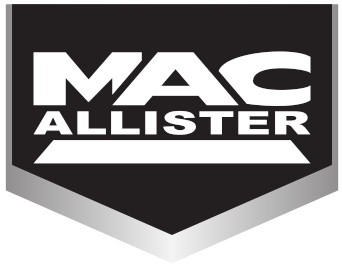
18V Combi Drill
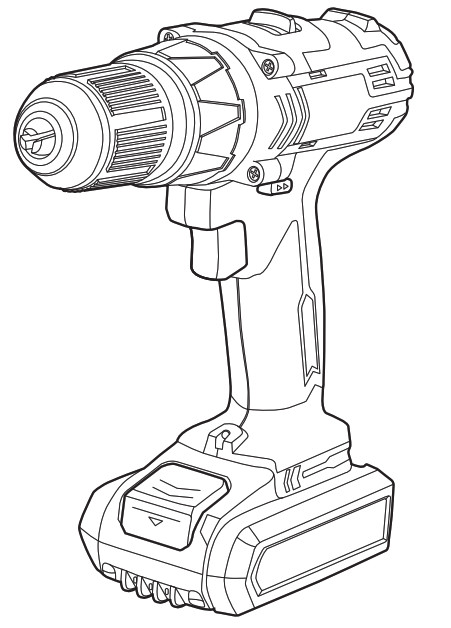
MSCD18-Li-2EAN: 3663602798446/EAN.3663602798453WARNING: Read the instructions before using the product!
Let’s get started
Safety warnings
General power tool safety warnings WARNING! Read all safety warnings, instructions, illustrations, and specifications provided with this power tool. Failure to follow all instructions listed below may result in electric shock, fire, and/or serious injury. Save all warnings and instructions for future reference. The term “power tool” in the warnings refers to your mains-operated (corded) power tool or battery-operated (cordless) power tool.
WARNING! Read all safety warnings, instructions, illustrations, and specifications provided with this power tool. Failure to follow all instructions listed below may result in electric shock, fire, and/or serious injury. Save all warnings and instructions for future reference. The term “power tool” in the warnings refers to your mains-operated (corded) power tool or battery-operated (cordless) power tool.
Work area safety>Keep work area clean and well lit. Cluttered or dark areas invite accidents.>Do not operate power tools in explosive atmospheres, such as in the presence of flammable liquids, gases, or dust. Power tools create sparks that may ignite dust or fumes.>Keep children and bystanders away while operating a power tool. Distractions can cause you to lose control. Electrical safety>Power tool plugs must match the outlet. Never modify the plug in any way. Do not use any adapter plugs with earthed (grounded) power tools. Unmodified plugs and matching outlets will reduce the risk of electric shock.>Avoid body contact with earthed or grounded surfaces, such as pipes, radiators, ranges, and refrigerators. There is an increased risk of electric shock if your body is earthed or grounded.>Do not expose power tools to rain or wet conditions. Water entering a power tool will increase the risk of electric shock.>Do not abuse the cord. Never use the cord for carrying, pulling, or unplugging the power tool. Keep cord away from heat, oil, sharp edges, or moving parts. Damaged or entangled cords increase the risk of electric shock.>When operating a power tool outdoors, use an extension cord suitable for outdoor use. The use of a cord suitable for outdoor use reduces the risk of electric shock.>If operating a power tool in a damp location is unavoidable, use a residual current device (RCD) protected supply. The use of an RCD reduces the risk of electric shock. Personal safety>Stay alert, watch what you are doing, and use common sense when operating a power tool. Do not use a power tool while you are tired or under the influence of drugs, alcohol, or medication. A moment of inattention while operating power tools may result in serious personal injury.>Use personal protective equipment. Always wear eye protection. Protective equipment such as a dust mask, nonskid safety shoes, hard hat, or hearing protection used for appropriate conditions will reduce personal injuries.>Prevent unintentional starting. Ensure the switch is in the off-position before connecting to a power source and/ or battery pack, picking up or carrying the tool. Carrying power tools with your finger on the switch or energizing power tools that have the switch on invites accidents.>Remove any adjusting key or wrench before turning the power tool on. A wrench or a key left attached to a rotating part of the power tool may result in personal injury.>Do not overreach. Keep proper footing and balance at all times. This enables better control of the power tool in unexpected situations.>Dress properly. Do not wear loose clothing or jewelry. Keep your hair and clothing away from moving parts. Loose clothes, jewelry, or long hair can be caught in moving parts. >If devices are provided for the connection of dust extraction and collection facilities, ensure these are connected and properly used. The use of dust collection can reduce dust-related hazards.>Do not let familiarity gained from frequent use of tools allow you to become complacent and ignore tool safety principles. A careless action can cause severe injury within a fraction of a second. Power tool use and care>Do not force the power tool. Use the correct power tool for your application. The correct power tool will do the job better and safer at the rate at which it was designed.>Do not use the power tool if the switch does not turn on and off. Any power tool that cannot be controlled with the switch is dangerous and must be repaired.>Disconnect the plug from the power source and/or remove the battery pack, if detachable, from the power tool before making any adjustments, changing accessories, or storing power tools. Such preventive safety measures reduce the risk of starting the power tool accidentally.>Store idle power tools out of the reach of children and do not allow persons unfamiliar with the power tool or these instructions to operate the power tool. Power tools are dangerous in the hands of untrained users.>Maintain power tools and accessories. Check for misalignment or binding of moving parts, breakage of parts, and any other condition that may affect the power tool’s operation. If damaged, have the power tool repaired before use. Many accidents are caused by poorly maintained power tools.>Keep cutting tools sharp and clean. Properly maintained cutting tools with sharp cutting edges are less likely to bind and are easier to control.>Use the power tool, accessories and tool bits, etc. in accordance with these instructions, taking into account the working conditions and the work to be performed. Use of the power tool for operations different from those intended could result in a hazardous situation.>Keep handles and grasping surfaces dry, clean, and free from oil and grease. Slippery handles and grasping surfaces do not allow for safe handling and control of the tool in unexpected situations. Battery tool use and care>Recharge only with the charger specified by the manufacturer. A charger that is suitable for one type of battery pack may create a risk of fire when used with another battery pack.>Use power tools only with specifically designated battery packs. Use of any other battery packs may create a risk of injury and fire.>When the battery pack is not in use, keep it away from other metal objects, like paper clips, coins, keys, nails, screws, or other small metal objects that can make a connection from one terminal to another. Shorting the battery terminals together may cause burns or a fire.>Under abusive conditions, liquid may be ejected from the battery; avoid contact. If contact accidentally occurs, flush with water. If liquid contacts eyes, additionally seek medical help. Liquid ejected from the battery may cause irritation or burns.>Do not use a battery pack or tool that is damaged or modified. Damaged or modified batteries may exhibit unpredictable behavior resulting in fire, explosion, or risk of injury. >Do not expose a battery pack or tool to fire or excessive temperature. Exposure to fire or temperature above 130 °C may cause an explosion.>Follow all charging instructions and do not charge the battery pack or tool outside the temperature range specified in the instructions. Charging improperly or at temperatures outside the specified range may damage the battery and increase the risk of fire. Service>Have your power tools serviced by a qualified repair person using only identical replacement parts. This will ensure that the safety of the power tool is maintained.>Never service damaged battery packs. Service of battery packs should only be performed by the manufacturer or authorized service providers. Drill safety warnings>Wear ear protectors when impact drilling. Exposure to noise can cause hearing loss.>Use auxiliary handle(s), if supplied with the tool. Loss of control can cause personal injury.>Hold the power tool by insulated gripping surfaces, when performing an operation where the cutting accessory or fasteners may contact hidden wiring. Cutting accessory contacting a “live” wire may make exposed metal parts of the power tool “live” and could give the operator an electric shock. Additional safety warnings for charger>This charger can be used by children aged 8 years and above and persons with reduced physical, sensory or mental capabilities or lack of experience and knowledge if they have been given supervision or instruction concerning the use of the charger in a safe way and understand the hazards involved.>Children shall not play with the charger. Cleaning and user maintenance shall not be made by children without supervision.>Disconnect the charger from the power supply and allow it to cool down before cleaning, maintenance, storage, and transportation.>Before using the charger read all the instructions and cautionary markings on the charger and battery pack.>The charger and battery pack supplied with it are specifically designed to work together.Only use the charger with the battery pack specified for this product. >Charge the battery pack indoors only as the charger is designed for indoor use only.>Do not charge non-rechargeable batteries.>Protect the charger against moisture and wet conditions. There is a danger of electric shock.>Do not place any object on top of the charger as it could cause overheating. Do not place the charger near any heat source.>Do not use an extension cord unless it is absolutely necessary. The use of an improper extension cord could cause the risk of fire, electric shock, or electrocution.>Do not use the charger if it has been subjected to a heavy knock, dropped, or otherwise damaged in any way. Have the charger checked and repaired by an authorized service center. Additional safety warnings for battery packs>Do not attempt to charge the battery pack with any other charger than the one supplied. The charger and battery pack supplied with it are specifically designed to work together.>Charge and store the battery pack in an ambient temperature of 18 – 24°C (65 – 75°F) to ensure the longest battery life and best performance. Do not charge or store the battery pack in temperatures below 0°C (32°F) and above 45°C (113°F).>Never attempt to open the battery pack for any reason. If the plastic housing of the battery pack breaks open or cracks, immediately discontinue its use and do not recharge it. >Do not store or carry a spare battery pack in a pocket or toolbox or any other place where it may come into contact with metal objects. The battery pack may be short-circuited causing damage to the battery pack, burns, or a fire.>Do not pierce the battery pack with nails, strike the battery pack with a hammer, step on the battery, or otherwise subject it to strong impacts or shocks.>Protect the battery pack against heat. Do not place the battery pack in direct sunlight or use or store the battery pack inside cars in hot weather. Doing so may cause the battery pack to generate heat, explode or ignite.>Never try to charge a battery pack that is cracked or damaged in any other way. There is a danger of electric shock or electrocution.
The following information applies to professional users only but is good practice for all users:ADDITIONAL SAFETY WARNING FOR CONSTRUCTION DUST The updated Control of Substances Hazardous to Health Regulations 1st October 2012 now also targets to reduce the risks associated with silica, wood and gypsum dusts. Construction workers are one of the at-risk groups within this because of the dust that they breathe: silica dust is not just a nuisance, it is a real risk to your lungs! Silica is a natural mineral present in large amounts in things like sand, sandstone and granite. It is also commonly found in many construction materials such as concrete and mortar. The silica is broken into very fine dust (also known as Respirable Crystalline Silica or RCS) during many common tasks such as cutting, drilling and grinding. Breathing in very fine particles of crystalline silica can lead to the development of: Lung cancer Silicosis Chronic Obstructive Pulmonary Disorder/ Chronic obstructive pulmonary disease (COPD) And breathing in fine particles of wood dust can lead to the development of Asthma. The risk of lung disease is linked to people who regularly breathe construction dust over a period of time, not on the odd occasion. To protect the lung, the COSHH Regulations sets a limit on the amount of this dust that you can breathe (called a Workplace Exposure Limit or WEL) when averaged over a normal working day.These limits are not a large amount of dust: when compared to a penny it is tiny – like a small pinch of salt: This limit is the legal maximum, the most you can breathe after the right controls have been used.How to reduce the amount of dust?1. Reduce the amount of cutting by using the best sizes of building products.2. Use a less powerful tool e.g. a block cutter instead of an angle grinder.3. Using a different method of work altogether – e.g. using a nail gun to direct fasten cable trays instead of drilling holes first. Please always work with approved safety equipment, such as those dust masks that are specially designed to filter out microscopic particles and use the dust extraction facility at all times. For more information please see the HSE website: http://www.hse.gov.uk/construction or [PDF]
Warning: Some dust particles created by power sanding, sawing, grinding, drill, and other construction jobs contain chemicals known to cause cancer, birth defects or other reproductive harm. Some examples of these chemicals are>Lead from lead-based paints.>Crystalline silica from bricks and cement and other masonry products.>Arsenic and chromium from chemically treated timber. Your risk from these exposures varies, depending upon how often you do this type of work.To reduce your exposure to these chemicals:>Work in a well-ventilated area.>Work with approved safety equipment, such as those dust masks that are specially designed to filter microscopic particles.
VIBRATIONThe European Physical Agents (Vibration) Directive has been brought in to help reduce hand-arm vibration syndrome injuries to power tool users. The directive requires power tool manufacturers and suppliers to provide indicative vibration test results to enable users to make informed decisions as to the period of time a power tool can be used safely on a daily basis and the choice of tool.
SEE TECHNICAL SPECIFICATIONS IN THE INSTRUCTION MANUAL FOR THE VIBRATION LEVELS OF YOUR TOOL.The declared vibration emission value should be used as a minimum level and should be used with the current guidance on vibration. Calculating the actual period of use can be difficult and the HSE website has further information. The declared vibration emission has been measured in accordance with a standardized test stated above and may be used to compare one tool with another tool. The declared vibration emission value may also be used in a preliminary assessment of exposure.
Warning: The vibration emission value during actual use of the power tool can differ from the declared value depending on the ways in which the tool is used depending on the following examples and other variations on how the tool is used: How the tool is used and the materials being cut or drilled. The tool is in good condition and well maintained. The use of the correct accessory for the tool and ensuring it is sharp and in good condition. The tightness of the grip on the handles. And the tool is being used as intended by its design and these instructions.
While working with this power tool, hand/arm vibrations occur. Adopt the correct working practices in order to reduce the exposure to vibration. This tool may cause hand-arm vibration syndrome if its use is not adequately managed.
Warning: Identify safety measures to protect the operator that is based on an estimation of exposure in the actual conditions of use (taking account of all parts of the operating cycle such as the times when the tool is switched off and when it is running idle in addition to the trigger time).
Note: The use of other tools will reduce the users’ total working period on this tool.Helping to minimize your vibration exposure risk. ALWAYS use sharp chisels, drills, and blades. Maintain this tool in accordance with these instructions and keep well lubricated (where appropriate). Avoid using tools in temperatures of 10ºC or less. Plan your work schedule to spread any high vibration tool use across a number of days.
Health surveillanceAll employees should be part of an employer’s health surveillance scheme to help identify any vibration-related diseases at an early stage, prevent disease progression and help employees stay in work.
Emergency Familiarise yourself with the use of this product by means of this instruction manual. Memorize the safety directions and follow them to the letter. This will help to prevent risks and hazards.
Always be alert when using this product, so that you can recognize and handle risks early. Fast intervention can prevent serious injury and damage to property.>Switch off and disconnect from the power supply if there are malfunctions. Have the product checked by a qualified professional and repaired, if necessary, before you operate it again.
Residual risksEven if you are operating this product in accordance with all the safety requirements, potential risks of injury and damage remain. The following dangers can arise in connection with the structure and design of this product:>Health defects resulting from vibration emission if the product is being used over long periods of time or not adequately managed and properly maintained.>Injuries and damage to property due to broken cutting attachments or the sudden impact of hidden objects during use.>Danger of injury and property damage caused by flying objects.
Symbols
On the product, the rating label, and within these instructions, you will find among others the following symbols and abbreviations. Familiarise yourself with them to reduce hazards like personal injuries and damage to property.
| V~ | Volt, (alternating voltage) | yyWxx | Manufacturing date code; year of manufacturing (20yy) and week ofmanufacturing (Wxx). |
| Hz |
 |
Switch the product off and remove battery pack before assembly, cleaning,adjustments, maintenance, storage and transportation. | |
| w | Hertz |   |
This is a product of class II. This means it is equipped with an insulation reinforced or double insulation. |
| A | Watt | C° | Degree Celsius |
| mA | Ampere | Nm | Newton meter |
| mAH | Milliampere | /min or min-1 | Per minute |
| Milliampere-hour | mm | Milimeter | |
| Lock / to tighten or secure. | kg | Kilogram | |
| Unlock / to loosen. | dB(A) | Decibel (A-rated) | |
| Note/Remark | m/s2 | Meter per second squared | |
  |
Caution/Warning. |   |
Wear hearing protection. |
  |
Read the instruction manual. |   |
Wear eye protection. |
| Manufacturing date code; year of manufacturing (20yy) and week ofmanufacturing (Wxx). |      |
Wear protective gloves.Wear protective, slip-resistant footwear. |
| The product complies with the applicable European directives and anevaluation method of conformity for these directives was done. |   |
Do not dispose of battery packs in fire. They will explode and cause injury. | |
   |
WEEE symbol. Waste electrical products should not be disposed ofwith household waste. Please recycle where facilities exist. Check withyour Local Authority or local store for recycling advice. |   |
Do note expose battery packs to heat in excess of 45ºC. Do not charge or store the battery pack in temperatures below 0°C(32°F) and above 45°C (113°F). |
   |
Crossed out dust bin. Batteries and battery packs should not bedisposed of with household waste. Please recycle where facilitiesexist. Check with your Local Authority or local store for recyclingadvice. |   |
Approx. 1h charging time. |
  |
Indoor use only. |   |
Time lag fuse with rated current of 3.15A |
  |
Do not dispose of battery packs in rivers or immerse in water. |
Your product


| 1. Work light | 7. Handle |
| 2. Keyless chuck | 8. Battery pack |
| 3. Torque adjustment ring | 9. Release button |
| 4. Two-speed gear control | 10. Power / charging status indicator light |
| 5. Forward/Reverse rotation control switch | 11. Charging base |
| 6. ON/OFF switch with variable speed | 12. Charger |
Technical specifications
| Drill | |
| > Rated voltage | 18 V d.c. |
| > Rated no load speed n0 | 0-420/0-1600 min-1 |
| > Max. torque | 35Nm |
| > Chuck capacity | ø13 mm |
| > Drilling capacity | wood ø30 mmmetal ø10 mmconcrete ø13 mm |
| > Weight | approx. 1.5 kg |
| Battery pack | |
| > Model no. | MBAT18-Li |
| > Type | Li-Ion |
| > Capacity | 1.5 Ah |
| > Voltage | 18V d.c. |
| > Weight | approx. 0.4 kg |
| Charger | |
| > Model no. | MC18BS-Li |
| > Rated input | 220 – 240 V~, 50/60 Hz, 37 W |
| > Rated output | 20V d.c. , 1.5 A |
| > Charging time | approx. 1h |
| > Weight | approx. 0.2 kg |
| Sound values | |
| > Sound pressure level LpA | 87 dB(A) |
| > Sound power level LWA | 98 dB(A) |
| > Uncertainty KpA, KWA | 3 dB(A) |
| Hand arm vibration values | |
| > drilling into metal ah,D | 2.2 m/s 2 |
| > Impact drilling into concrete ah,ID | 10.8 m/s 2 |
| > Uncertainty K | 1.5 m/s 2 |
Rating Label ExplanationMSCD18-Li-2 = MODEL NUMBERMS = MacAllister(Brand)CD = Combi drill18 = 18VoltsLi = Lithium Ion battery2 = 2 speed
Before you start
Unpacking1. Unpack all parts and lay them on a flat, stable surface.2. Remove all packing materials and shipping devices if applicable.3. Make sure the delivery contents are complete and free of any damage. If you find that parts are missing or show damage do not use the product but contact your dealer.Using an incomplete or damaged product represents a hazard to people and property.4. Ensure that you have all the accessories and tools needed for assembly and operation.This also includes suitable personal protective equipment.
![]()
![]()
![]()
![]()
![]()
![]()
![]()
![]()
![]()
![]()
![]()
![]()
| (items not supplied) | (Items supplied) |
| > suitable personal protective equipment> suitable drill bits> suitable driver bits> bit adaptor> cooling lubricant (for drilling into metal) | 1x battery pack(EAN: 3663602798446)2x battery pack(EAN: 3663602798453)1x charger |
Setup![]()
![]()
![]()
![]()
![]()
![]()
![]()
![]()
![]()
![]()
![]()
![]()



Drill/Driver bitsDifferent drill and driver bits can be used with this product depending on the material being worked with.
![]()
![]()
![]()
![]()
![]()
![]()
![]()
![]()
![]()
![]()
![]()
![]()



Inserting> Turn the chuck sleeve (2) anticlockwise until the chuck jaws are opened wide enough to insert the drill bit (Fig. 1).> Insert the drill bit all the way to the stop (Fig. 2). If using a 25 mm driver bit, insert it into the socket of a bit holder.> Turn the chuck sleeve (2) clockwise until the drill bit is properly fastened in the chuck jaws (Fig. 3).


Removing / Replacing> Turn the chuck sleeve (2) anticlockwise until the chuck jaws are opened wide enough to remove the bit.> Remove the bit and insert a new one as described above if desired.
Battery pack Release / Attach> Lock the ON/OFF switch (6) to avoid accidental starting by moving the forward/reverse rotation control (5) into the middle position(see section “Product functions – Forward / reverse rotation control”).> To remove the battery, press the release button (9) and pull out the battery pack (8) from the product (Fig. 4).> To attach the battery to the product, align the battery pack (8) with the sliding slots of the battery docking port and slide the battery pack in. Ensure it clicks in place (Fig. 5).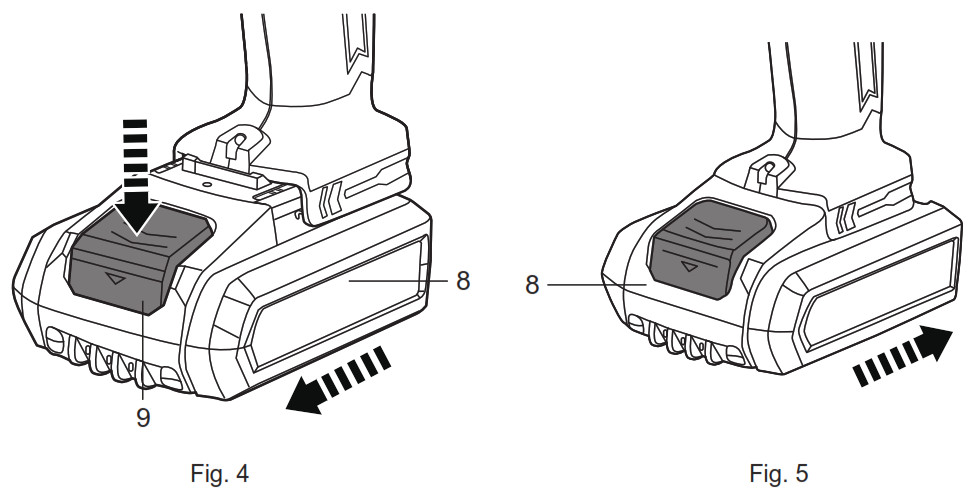

![]()
![]()
![]()
![]()
![]()
![]()
![]()
![]()
![]()
![]()
![]()
![]()


> Slide the battery pack (8) into the charger base (11) until it locks in place (Fig. 6).> Connect the charger (12) to the power supply. The indicator light (10) lights in red when the battery is charging and green when charging is finished.> After charging is finished, disconnect the charger (12) from the power supply and remove the battery pack (8) from the charger base (11) by pressing the release button (9) and pulling out the battery pack (8) (Fig. 7).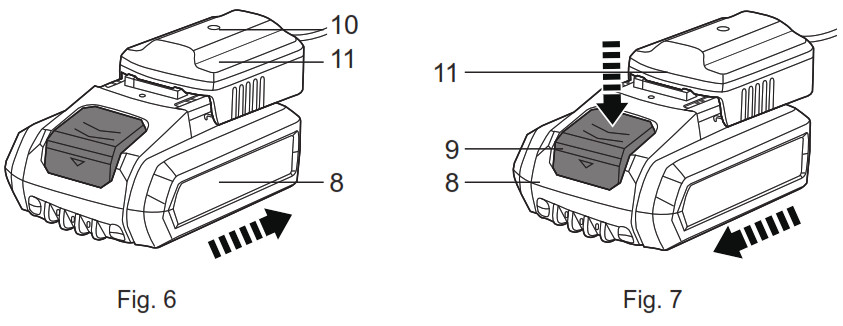

In more detail…
Intended use
The product is intended for driving in and loosening screws as well as for drilling in wood, metal, plastic, and for impact drilling in brickwork/masonry. It should not be used for working on materials that are dangerous to health. It must not be used for tightening or loosening car wheel nuts. For safety reasons it is essential to read the entire instruction manual before first operation and to observe all the instructions therein.
Product functions
Switching ON/OFF (Fig. 8)> Switch the product on by pressing the ON/OFF switch (6).> Switch the product off by releasing the ON/OFF switch (6).It is also a variable speed switch that delivers higher speed and torque with increased trigger pressure. Speed is controlled by the amount of switch trigger depression.
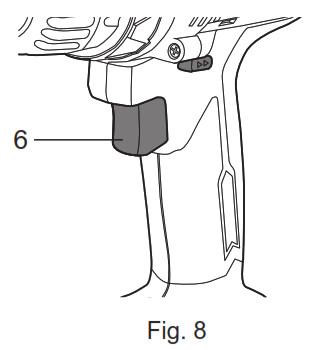

![]()
![]()
![]()
![]()
![]()
![]()
![]()
![]()
![]()
![]()
![]()
![]()
Forward / reverse rotation controlChange the rotational direction from forward to reverse by pressing the forward/reverse rotation control (5).
![]()
![]()
![]()
![]()
![]()
![]()
![]()
![]()
![]()
![]()
![]()
![]()


> Move the forward/reverse rotation control switch (5) to the left (as seen from the operator’s position) in order to use the product in a clockwise rotational mode (Fig. 9).> Move the forward/reverse rotation control switch (5) to the right (as seen from the operator’s position) in order to use the product in anticlockwise rotational mode (Fig. 10).> Move the forward/reverse rotation control switch (5) to the center position to lock the on/off switch and avoid accidental starting (Fig. 11).
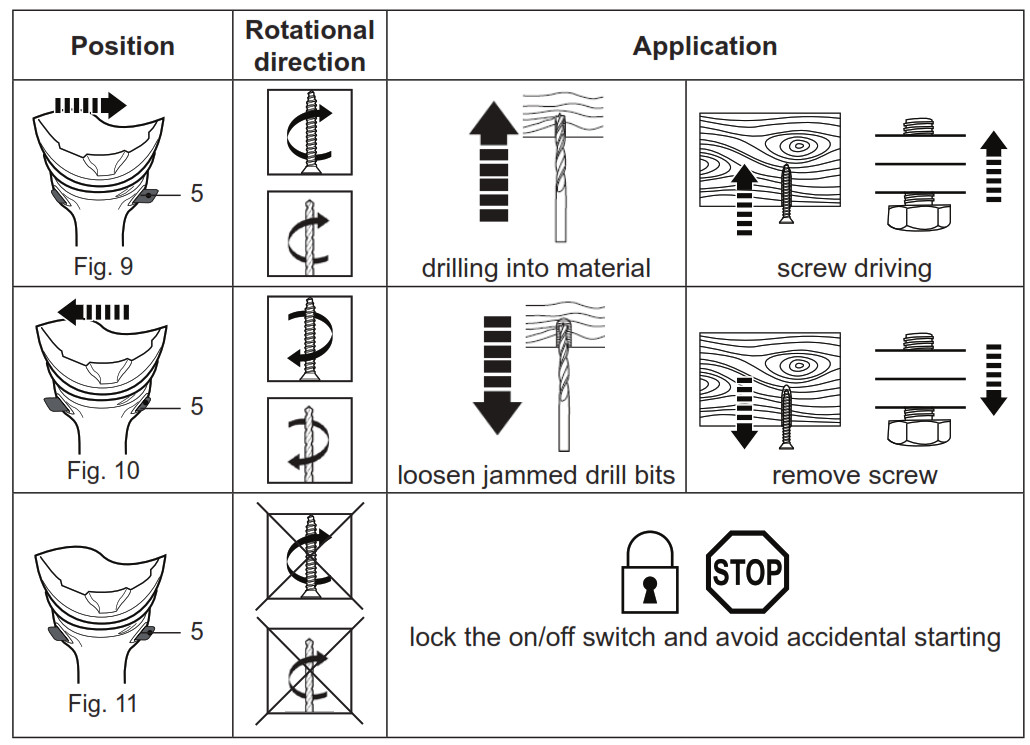





Automatic work light (Fig. 12)The work light (1) will automatically illuminate by pressing the ON/OFF switch (6).
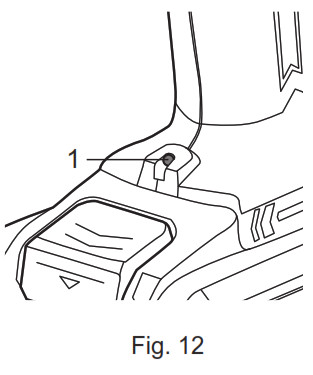

![]()
![]()
![]()
![]()
![]()
![]()
![]()
![]()
![]()
![]()
![]()
![]()
Two-speed gear control The two-speed gear control (4) is used to switch between two working modes. When the gear is set to position 1, the speed will decrease and the drill will have greater power and torque. When the gear is set to position 2, the speed will increase and the drill will have less power and torque (Fig. 13)
| Gear position | Description |
| 1 | Low-speed range for screwdriver or working with large drilling diameter |
| 2 | High-speed range for working with small drilling diameter |
![]()
![]()
![]()
![]()
![]()
![]()
![]()
![]()
![]()
![]()
![]()
![]()
Torque adjustment (Fig. 14)The torque is adjusted by rotating the torque adjustment ring (3). The torque is greater when the torque adjustment ring is set on a higher setting. The torque is lower when the torque adjustment ring is set on a lower setting.
| Torque | Description |
| 1 – 4 | for driving small screws |
| 5 – 9 | for driving screws into soft material |
| 10 – 14 | for driving screws into soft and hard material |
| 15 – 17 | for driving screws into hard wood |
| 18+ | for driving larger screws |
| for heavy drilling in wood,plastic and metal | |
  |
for impact drilling in masonry and concrete |
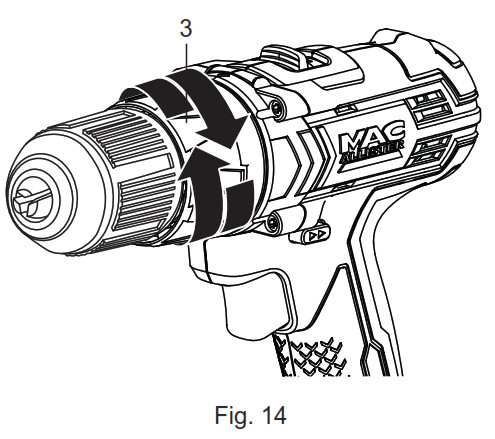

Automatic spindle lock (Fig. 15) The automatic spindle lock allows you to use it as a regular screwdriver. You can give an extra twist to firmly tighten a screw, loosen a very tight screw or continue working when the battery energy has expired. For manual screwdriver purposes, the chuck is automatically locked when the tool is off


General operation
Check the product, its battery pack and charger as well as accessories for damage before each use. Do not use the product if it is damaged or shows wear.> Double check that the accessories and attachments are properly fixed.> Always hold the product on its handle. Keep the handle dry to ensure safe support.> Ensure that the air vents are always unobstructed and clear. Clean them if necessary with a soft brush. Blocked air vents may lead to overheating and damage the product.> Switch the product off immediately if you are disturbed while working by other people entering the working area. Always let the product come to complete stop before putting it down.> Do not overwork yourself. Take regular breaks to ensure you can concentrate on the work and have full control over the product.
![]()
![]()
![]()
![]()
![]()
![]()
![]()
![]()
![]()
![]()
![]()
![]()
Drilling> Set the torque ring to drilling mode when drilling into wood, plastic or metal, and hammer drilling mode for drilling into brickwork/masonry.> Always hold the product perpendicular to the point to be drilled. Holding it at an angle may cause slipping or jamming of the drill bit.> Always place the drill tip directly on the point to be drilled first and then switch the product on.> Pre-drill larger holes with a small diameter drill bit first. Doing so makes drilling with a larger diameter drill bit easier.> Do not always drill at top speed. This unnecessarily increases the wear and tear of the product and drill bit.> Remove blocked and stuck drill bits by changing the rotational direction.
Drilling into plastic and metal> Punch the drilling point before operation in order to avoid slipping of the drill.> Use a metal drill bit for drilling into plastic and metal. Select a low speed and where necessary use a cooling lubricant that is available at your specialist dealer.
Drilling into brickwork/masonry> An impact drill is ideal for drilling in normal masonry. If you want to drill into very hard concrete, you may require a rotary hammer.> Use an inspection device to ensure that you do not accidentally drill into a cable or pipe. Wear protective glasses when drilling.> Determine the exact position of the holes and mark them using a pencil. A cross-line laser will make this task easier for you.> Choose a masonry drill bit with the same diameter as the fixing you want to use. Mount the drill bit securely in the center of the chuck.> Place the drill bit tip perpendicular to the wall.If you do not exactly know the condition of the wall material, start drilling without impact and only switch the impact function on when there is resistance. Do not apply pressure to the machine until the drill bit has gripped firmly in the material.> Drill the hole so that it is deep enough for both the fixing and the screw to fit fully. Use a depth stop if necessary. Leave the drill bit running at low speed when you pull it out. > Remove the drilling dust from the hole. This will ensure that the fixing has a better grip.




Screw driving> Set the torque ring to screw driving mode (numbers).> Adjust the torque setting according to the screw size and workpiece material.> Pre-drill the holes with a smaller diameter of the screw to be screwed.> Hold the product perpendicular to the screw to be screwed in/out. Holding it at an angle may cause slipping or jamming of the driver bit.> Place the tip of the driver bit directly on the screw first and then switch the product on. Only apply as much pressure as necessary to keep the screw in place and the driver bit in contact with the screw head. Too much pressure will cause damage to the screw head and driver bit; too little pressure will cause the driver bit to slide away.> Remove blocked and stuck screws by changing the rotational direction.
Care and maintenance
After use> Switch the product off, remove the battery pack and let it cool down.> Check, clean and store the product as described below.The golden rules for care
![]()
![]()
![]()
![]()
![]()
![]()
![]()
![]()
![]()
![]()
![]()
![]()
![]()
![]()
> Keep the product clean. Remove debris from it after each use and before storage.> Regular and proper cleaning will help ensure safe use and prolong the life of the product.> Inspect the product before each use for worn and damaged parts. Do not operate it if you find broken and worn parts.
WARNING! Only perform repairs and maintenance work according to these instructions! All further works must be performed by a qualified specialist!
General cleaning> Clean the product with a dry cloth. Use a brush for areas that are hard to reach.> In particular clean the air vents after every use with a cloth and brush.> Remove stubborn dirt with high-pressure air (max. 3 bar).




> Check for worn or damaged parts. Replace worn parts as necessary or contact an authorized service center for repair before using the product again.MaintenanceBefore and after each use, check the product and accessories (or attachments) for wear and damage. If required, exchange them for new ones as described in this instruction manual. Observe the technical requirements.
Care and Maintenance / Troubleshooting
RepairThis product does not contain any parts that can be repaired by the consumer. Contact an authorized service center or a similarly qualified person to have it checked and repaired.Storage> Switch the product off and remove the battery pack.> Clean the product as described above.> Store the product and its accessories in a dark, dry, frost-free, well-ventilated place.> Always store the product in a place that is inaccessible to children. The ideal storage temperature is between 10°C and 30°C.> We recommend using the original package for storage or covering the product with a suitable cloth or enclosure to protect it against dust.Transportation> Switch the product off and remove the battery pack.> Attach transportation guards, if applicable.> Always carry the product by its handle.> Protect the product from any heavy impact or strong vibrations which may occur during transportation in vehicles.> Secure the product to prevent it from slipping or falling over.
Troubleshooting
Suspected malfunctions are often due to causes that the users can fix themselves. Therefore, check the product using this section. In most cases, the problem can be solved quickly.
![]()
![]()
![]()
![]()
![]()
![]()
![]()
![]()
![]()
![]()
![]()
![]()
| Problem | Possible cause | Solution |
| 1. Product does not start | 1.1. Forward/reverse rotation control switch at the center lock position1.2. Battery pack not properly attache1.3. Battery pack discharged1.4. Battery pack damaged1.5. another electrical defect to the product | 1.1. Push forward / reverse rotation control switch to left / right1.2. Attach properly1.3. Remove and charge battery pack1.4. Check by a specialist electrician1.5. Check by a specialist electrician |
| 2. Product does not reach full power | 2.1. Battery pack capacity too low2.2. Air vents are blocked | 2.1. Charge battery pack 2.2. Clean the air vents |
| 3. Unsatisfactory result | 3.1. Driver/drill bit is worn3.2. Driver/drill bit not suitable for intended operation | 3.1. Replace with a new one 3.2. Use suitable driver bit |
| 4. Product suddenly stops | 4.1. Product overloaded4.2. Battery pack discharged 4.3. Battery too hot | 4.1. Remove the product from the workpiece and switch it on again4.2. Remove and charge battery pack4.3. Remove battery pack and let it cool down |
Recycling and disposal
Waste electrical products should not be disposed of with household waste. Please recycle where facilities exist. Check with your local Authority or local store for recycling advice.


Disposal of an exhausted battery pack



Guarantee
At MacAllister we take special care to select high quality materials and use manufacturing techniques that allow us to create ranges of products incorporating design and durability. That’s why we offer a 2 year guarantee against manufacturing defects on our MacAllister power tool products.This power tool is guaranteed for 2 years from the date of purchase, if bought in store, delivered or if bought online. You may only make a claim under this guarantee upon presentation of your sales receipt or purchase invoice. Please keep your proof of purchase in a safe place.
This guarantee covers product failures and malfunctions provided the MacAllister power tool was used for the purpose for which it is intended and subject to installation, cleaning, care, and maintenance in accordance with standard practice and with the information contained above and in the user manual. This guarantee does not cover defects and damage caused by or resulting from:• Normal wear and tear• Overload, misuse, or neglect• Repairs attempted by anyone other than an authorized agent• Cosmetic damage• Damage caused by foreign objects, substances, or accidents• Accidental damage or modification• Failure to follow manufacturer’s guidelines• Loss of use of the goods
This guarantee is limited to parts recognized as defective. It does not, in any case, cover ancillary costs (movement, labor) and direct and indirect damage. If the MacAllister power tool is defective during the guarantee period, then we reserve the right, at our discretion, to replace the item with a product of equivalent quality and functionality or to provide a refund.
This guarantee only applies to the country of purchase or delivery and is not transferrable to any other country. This guarantee is non-transferable to any other person or product. Relevant local law will apply to this guarantee.
Guarantee-related queries should be addressed to a store affiliated with the distributor from where you purchased the MacAllister power tool. This guarantee is in addition to and does not affect your statutory rights relating to faulty goods as a consumer.
EC declaration of conformity



WeKingfisher International Products Limited3 Sheldon Square London W2 6PX United KingdomDeclare that the product:18V cordless combi drill MSCD18-Li-2Serial number: 000001-999999Complies with the essential health and safety requirements of the following directives:2006/42/EC The Machinery DirectiveReferences to the following harmonized standard were made:EN 60745-1: 2009+A11:2010EN 60745-2-1:20102014/30/EU Electromagnetic Compatibility DirectiveReferences to the following harmonized standard were made:EN 55014-1:2017EN 55014-2:2015Charger MC18BS-LiEN 55014-1:2017EN 55014-2:2015EN 61000-3-2:2014EN 61000-3-3:20132014/35/EU Low Voltage DirectiveReferences to the following harmonized standard were made:EN 60335-1: 2012 +A11: 2014+A13:2017EN 60335-2-29: 2004 +A2: 2010EN 62233 :20082011/65/EU Restrictions of the Use of Certain Hazardous Substances in Electrical and Electronic Equipment Authorised signatory and technical file holder:Kingfisher International Products Limited3 Sheldon SquareLondon W2 6PXUnited Kingdom
![]()
![]()



Manufacturer • Fabricant • Producent • Hersteller •Producator • Fabricante:Kingfisher International Products Limited,3 Sheldon Square, London, W2 6PX,United Kingdomwww.kingfisher.com/productsDistributor:B&Q plc,Chandlers Ford, Hants, SO53 3LEUnited Kingdomwww.diy.comScrewfix Direct Limited,Trade House, Mead Avenue,Yeovil, BA22 8RT, United Kingdomwww.screwfix.comTo view instruction manuals online,visit www.kingfisher.com/products.
References
[xyz-ips snippet=”download-snippet”]

